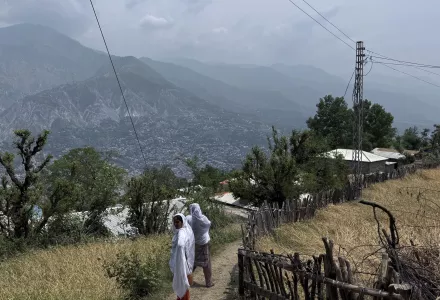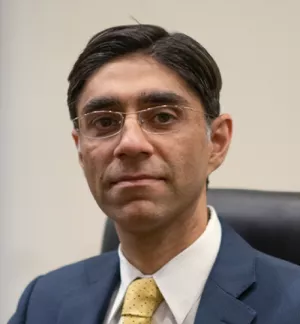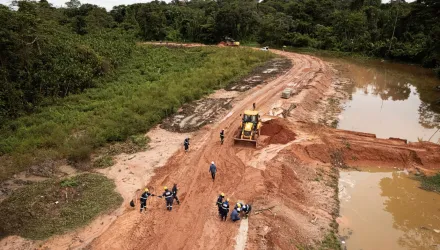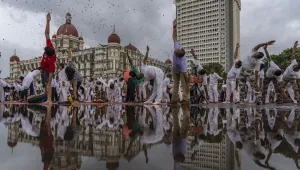As news of a major terrorist attack in Pahalgam in the disputed territory of Kashmir emerged on April 22, 2025, it was clear that nuclear neighbors India and Pakistan were headed for another major crisis. The attack, which Indian media took minutes to blame on Pakistan, killed 26 people. U.S. Vice President Vance was in India when the attack took place.
Almost two weeks later, the situation remains tense, with a discernable war frenzy having taken over in India. Indian Prime Minister Narendra Modi has given his armed forces “complete operational freedom to decide on the mode, targets and timing” of any Indian military action. Pakistan has responded with a mix of messages, calling for an inquiry into the terrorist incident before jumping to conclusions – India has been unable to provide any evidence linking the attack to Pakistan – while insisting that Indian use of force will be met with a “quid pro quo plus” response.
India and Pakistan are no strangers to crises. Since both tested nuclear weapons in 1998, they have stumbled into serious crisis moments at least half a dozen times. While the region’s nearly two billion population have escaped without any major harm, South Asia has been labeled the world’s most likely nuclear flashpoint. One key reason is that India and Pakistan lack robust bilateral crisis communication and escalation control mechanisms that were considered to be pivotal in preventing a nuclear exchange between the U.S. and Soviet Union during the Cold War.
Instead, as I explain in my book Brokering Peace in Nuclear Environments: U.S. Crisis Management in South Asia, New Delhi and Islamabad have banked on third party actors as the principle means of crisis de-escalation. The U.S. has been the single most important player, always proactively engaging in crisis mediation in a region it has had serious stakes in.
The White House may again have been the main reason India and Pakistan have not gone to war during the past week, although Washington’s calming influence on the Pahalgam crisis seems to have been accidental rather than planned.
U.S. Mediation in Previous South Asian Crises
South Asian crises between 1999 and 2015 were all handled through a diplomatic frenzy choreographed among multiple countries, with the U.S. unequivocally in the lead. U.S. allies such as the U.K. and Arab states in the Gulf coordinated efforts to reinforce America’s diplomatic intervention. Recognizing the necessity of preventing a major war in a nuclear environment, even non-U.S. allies like China and Russia tended to align their crisis diplomacy with Washington. Ultimately, third party success in convincing India and Pakistan to back down in crises was predicated on their singular focus on achieving de-escalation above all other geo-political considerations during the time of the crisis.
The U.S. crisis mediation playbook evolved over the past decade, informed largely by its fast-growing relationship with India and continued misgivings towards Pakistan due to their differences over the war in Afghanistan. The first change in America’s crisis signaling was evident in 2016, when India responded to a terrorist attack in Kashmir by claiming to have made the unprecedented move of conducting surgical strikes in Pakistani Kashmir. Even though the U.S. sought de-escalation, it never criticized the Indian strikes and in fact blamed Pakistan for not being able to control anti-India militancy. While Pakistan denied that any strikes had taken place, the 2016 crisis influenced Indian and Pakistani crisis behavior during the next crisis episode in 2019. Once again, a terrorist attack in Kashmir set off alarm bells. This time, India went further by becoming the first country to conduct air strikes deep inside the territory of a nuclear neighbor. This move did not signal willingness to fight a protracted war. Rather, India had been emboldened by America’s uncharacteristically favorable position towards it. At the time, I explained that “the United States took the clearest stance it had to date, with Secretary of State Mike Pompeo tweeting that the United States “stand[s] with India as it confronts terrorism.” National Security Advisor John Bolton reportedly amplified U.S. support for “India’s right to self-defense against cross-border terrorism” during a conversation with his Indian counterpart. India could have reasonably perceived this as tacit U.S. support for Indian military action. Indeed, this seems to have been the U.S. intent: to accept India’s need to let off steam and press Pakistan to hold back in response.” This is precisely how India wanted the crisis to end as well.
It did not work. Pakistan responded and, in the process, shot down an Indian jet and captured the pilot. With the risk of further escalation seemingly imminent, the U.S. and other third parties quickly changed their tone and reverted to prioritizing immediate de-escalation above all else. Shortly thereafter, Pakistan agreed to release the Indian pilot to end the crisis. Quite remarkably, India turned the pilot’s release into a narrative of victory at home and Prime Minister Modi rode this wave to win the Indian elections shortly thereafter.
The Trump Factor in the Pahalgam Crisis
India’s crisis strategy over the past week has been heavily informed by the third party’s crisis mediation approach during the 2019 episode. Perhaps further encouraged by President Donald Trump’s return to the White House, New Delhi once again planned to flex its military muscle against Pakistan – this time threatening even greater aggression. Multiple voices in India have called for a ‘final war’ with Pakistan, with even opposition party members advocating the nuclear neighbor’s annihilation. Third party backing was still a necessary ingredient for India’s success. Minus third party pressure to force an end to the crisis, India (or Pakistan) has no credible means of preventing an all-out war that could end in a catastrophe. The international community did not oblige – and fortunately so.
The U.S. chose a qualitatively different crisis role than in the past. Rather than seeking to lead international crisis diplomacy, it took a hands-off approach, leaving India to adjust its strategy. Aboard Air Force one, on April 25, President Trump remarked "They'll get it figured out one way or the other.” "There's great tension between Pakistan and India, but there always has been.” He also did not commit to contacting the leadership of the two countries. The U.S. administration was also not active in coordinating crisis diplomacy globally, leaving other capitals – none with the heft and influence the U.S. has had over New Delhi and Islamabad – to fill the vacuum. The Gulf countries, China, and European countries all urged restraint through statements and direct contacts with Indian and Pakistani officials but none even remotely hinted at support for any military action (from either side). U.S. Secretary of State Marco Rubio did speak to Indian and Pakistani decision makers on April 30, again primarily to urge restraint.
There is no evidence to suggest that the U.S.’s uncharacteristically detached posture was a thought out crisis strategy. It was more likely a consequence of competing domestic and global priorities and the atypical style of diplomacy of the current administration. While it left other global capitals uncertain of America’s intent, it crucially also ended up denting India’s resolve to use force against Pakistan.
South Asia in not out of the woods yet. While the third parties’ refusal to unequivocally censure Pakistan and embolden India has helped prevent immediate crisis escalation, it has left Prime Minister Modi in a commitment trap. The Indian government’s populist politics risks losing face if the government is seen unable to act against Pakistan despite creating an aura of invincibility vis-à-vis the neighbor in recent times. India needs a face saver to create a narrative of victory. In the 2019 episode, Pakistan provided that by releasing the pilot and letting India build a narrative that suited its political leadership. This time round, a different Pakistani civilian and military leadership is at the helm, and they do not seem inclined to offer that exit.
The Way Forward
Barring an Indian decision to dial down the anti-Pakistan crisis rhetoric and Pakistan’s willingness to allow Prime Minister Modi to declare victory at home, the end to this crisis may need the international community to make gestures that offer a win-win to both sides. This could come in the form of fresh statements from the U.S. and other capitals denouncing the terrorist attack in Pahalgam while urging Pakistan to reiterate its offer to support any investigation into the incident.
Even this however would offer only temporary relief – till a new crisis, triggered by terrorism or otherwise, brings South Asia back to the brink. The deeper problem here is that the underlying reasons for tensions between these nuclear neighbors remain unaddressed. The international community’s interest has been restricted to crisis management, with little attention to crisis prevention that requires more sustained effort to nudge both sides towards normalization of ties. This would be the only way to avoid recurring dangerous crises in the region.
The events of the last week have made the need to do so greater than ever. As a punitive response to the Pahalgam attack, India has unilaterally suspended the World Bank-brokered Indus Water Treaty that regulates water distribution between the two countries. Without it, Pakistan will be starved of water. Pakistan, in response, has threatened to suspend the Simla Agreement that offers a bilateral framework for dispute resolution. If these provocations are not reversed, there will be fresh existential questions facing India and Pakistan, making the situation even more ripe for future crises. Already, Islamabad has threatened military action if India diverts waters by building new reservoirs on the rivers that flow into Pakistan. India, meanwhile, has cut off virtually all remaining engagement across multiple sectors between the two sides.
No matter how major their differences, the only sensible way forward is dialogue between these neighbors. Indeed, all previous times when India and Pakistan made progress in their relationship, they had serious conversations – mostly through back channels – to thank. Interestingly, most of these moments occurred in the wake of crises that gave both sides pause and forced a recognition of the impracticality of conflict in a nuclear environment. The U.S. and other third parties with influence over South Asia must ensure that India and Pakistan walk away with the same conclusion from the current episode. The international community should find ways to facilitate India and Pakistan’s return to the negotiation table – with the intent to address all their outstanding issues in a mutually acceptable and sustainable manner.
Failing this, the visceral hatred for Pakistan in India and the prevailing enough is enough attitude in Pakistan vis-à-vis India all but ensures that we will back into crisis mode sooner rather than later. The risks of heightened tensions in nuclear South Asia are too high for the world to allow this to happen. Recurring India-Pakistan crises, let alone war, also directly undermine U.S. interests in South Asia since they will keep India bogged down and distracted from America’s larger objective of using India as a counterweight to China.






